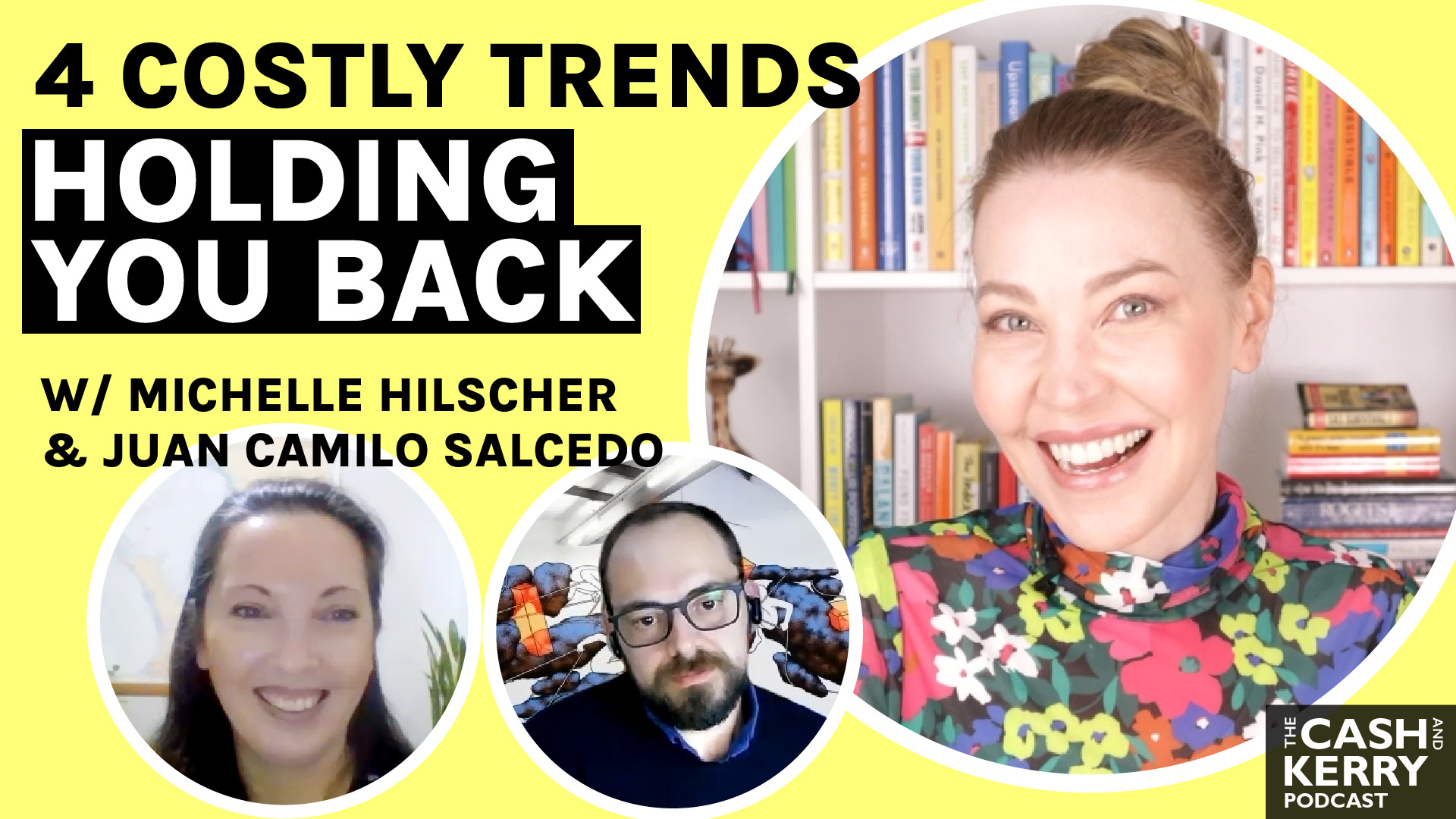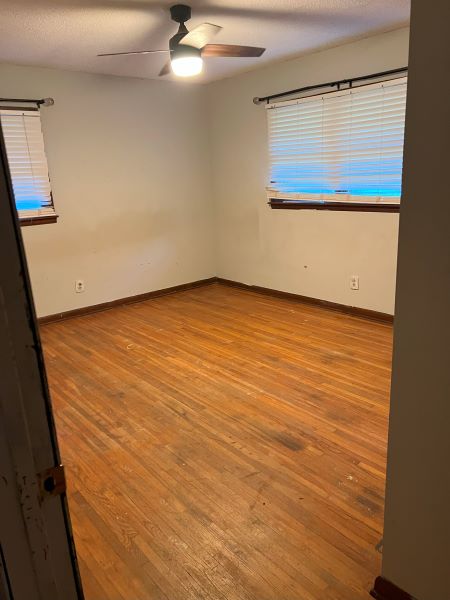Kerry K. Taylor: Welcome to the Cash and Kerry Podcast, where we help you make wiser financial decisions and build better money habits to increase your wealth, health, and happiness. Today we’re talking about how the cost of living and inflation are changing our mindset around money. Our financial situations may have changed and many of us haven’t felt this kind of pressure before.
Kerry K. Taylor: Maybe it’s a little debt or maybe you just can’t seem to get ahead. If this sounds like you, I have a treat for you today. I’ve got two behavioral scientists to help us navigate this new normal with proven ways to help. Michelle Hilscher is a Vice President at BEworks, and Juan Camilo Salcedo is the regional director in Latin America At BEworks.
Kerry K. Taylor: You’re gonna learn about four financial trends that may be holding you back and how to fix them. So let’s do this. Michelle and Juan, thank you so much for joining us today.
Michelle Hilscher: Thanks for having us. We’re really excited.
Kerry K. Taylor: I always love having a behavioral scientist here because you guys tell us what’s really going on with our money.
Michelle Hilscher: Absolutely. It’s really nice to be here and to be able to talk about some of the hidden biases and other things that people don’t necessarily know is influencing their behavior.
Kerry K. Taylor: We’re gonna reveal all. Okay, let’s jump right in. So the first question I have is, um, things have really changed since the pandemic.
Kerry K. Taylor: The cost of living is making it really hard to live. And now with inflation and interest rates on the rise, we really seem to have less and less money. Has our mindset changed over this time?
Michelle Hilscher: I think I can start there. Um, for us and what, what we’ve been realizing is that, you know, there’s two things that are happening.
Michelle Hilscher: Number one, we have biases and we have different shortcuts that we always use no matter the conditions, no matter the environment, no matter, you know, what the market’s doing and those things are happening and they have been happening, uh, through the pandemic. And so they have predictable kind of outcomes that we’re seeing that mean that we’re very similar despite what’s gone on during the pandemic.
Michelle Hilscher: But then there are other things that have, I think, made certain biases more pronounced than normal, maybe because of the pandemic and, and sort of shifted the way that we relate to money. And what we’re actually doing with that money. Um, for example, if we’re thinking about, you know, credit, then if we’re looking in Canada for an example, uh, what we would see is that, yeah, we’ve got folks who’ve actually seen some success.
Michelle Hilscher: Maybe not success that they’ve necessarily had in the past when it comes to paying off, uh, money that, that they have spent and, and loans that they, uh, owe against. And so I think what it means is that we’ve got folks who are feeling maybe more optimistic than normal, maybe a little bit more competent than usual as they’re looking at, you know, what might be coming in, uh, the year, the year in front of us.
Michelle Hilscher: So that’s a good thing. And I think if we’re looking maybe more in, in LATAM, which is where Juan’s located, then what we’re seeing is that during the pandemic, as people were, you know, kind of thinking about how to use their, their money, uh, that there were some changes that happened there too. And that is with regards to, you know, maybe paying not with, uh, not with credit , but actually looking at alternative ways of paying.
Michelle Hilscher: And so I think folks were maybe a bit more experimental and trying to, to pay in ways that weren’t usual for them. And I think what that means is that maybe they’re more likely to try other types of financial behaviors, uh, that they normally would not. So it could be something that we can capitalize on taking advantage of people’s flexibility of mind.
Juan Camilo Salcedo: And, and if I can, um, just jump in and build on what Michelle just mentioned. In Latin America in particular, um, there’s two components that play a big role. First, the, the large, um, economy that is not formal, the informal economy, uh, where a lot of low income individuals in particular, um, work. And secondly, a very, uh, growing participation of fintechs.
Juan Camilo Salcedo: So, uh, especially, uh, middle and low income individuals have been taking advantage of these, alternative modes of payment, of acquiring funds to, uh, to purchase the things that they want. And that has been playing a big role, but I think, something that is sort of transversal that, that, that captures, um, everywhere in the world, a global economy is the worry, uh, that is coming for the next year, right?
Juan Camilo Salcedo: We’re coming out of a pandemic, um, coupled with the sort of global instability precipitated by the situation in Ukraine and Russia. And now there seems to be a, a. Um, looming global tightening of credit and of funds. And so that’s gonna be something that is gonna be, uh, on people’s minds. And so that also starts to build on what we call scarcity mindset.
Juan Camilo Salcedo: The scarcity mindset, where we feel we start to feel even. At this point where we might not feel like there’s less cash in our account and less money on an account, that starts to play as a role. Uh, play an important role. And it can be monetary scarcity mindset, so scarcity of of funds, but it can also be that you’re busy trying to get another job.
Juan Camilo Salcedo: You have less time. So scarcity of time and scarcity of cognitive resources. Also, uh, happens as a result of, of, of all these, um, different types of scarcity mindsets, and that has a direct and oftentimes detrimental impact on our financial decision making.
Kerry K. Taylor: Right. I remember you guys, um, some of your research, you also talk about, uh, things like tunneling that can, that can also be a part of, uh, uh, the scarcity mindset and dealing with like the present bias.
Kerry K. Taylor: What are these?
Juan Camilo Salcedo: Yeah, certainly. So, so, um, what happens when you’re in a scarcity mindset is that you’re only focused on, uh, the funds that you have now, your necessities, your needs in the moment. And so what that, uh, brings about is what you, as you mentioned, a tunneling effect where you failed to take into account other alternatives, other options, other solutions maybe to the problems that you have, other solutions to your financial conundrums. Um, and so that have a negative impact on your overall decision making. Um, and likewise the, the present bias where you’re just focusing what you need right now, what do I need right now?
Juan Camilo Salcedo: And you fail to, um, put into perspective what you might need in the future. So there is a sort of, Uh, focusing on present needs at at the detriment of future needs.
Michelle Hilscher: Right. I got a nice example there actually from some of the work that we’ve done. Um, I don’t know Kerry, if you’ve ever like taken advantage of one of those retrofit programs, but you know, some governments will say, you know, if you install new windows, we’ll give you back some of what you spent or if you get a more eco-friendly furnace then we’ll pay back some of what it costs to buy and install that. Um, so we, we’ve worked with clients who are running these programs and what they find is that a lot of people are not actually taking advantage of money that’s on the table for them to claim if they go through with something like this type of retrofit.
Michelle Hilscher: And what we realized there is that a lot of times it’s households, right, who have this kind of scarcity mindset. Determining for them, uh, where they look for solutions if they’re cash strapped. And where they’re not looking is typically these kinds of programs because they maybe just aren’t on those folks’ horizons.
Michelle Hilscher: Like they just don’t recognize that it’s an option. So that’s kind of tunneling where you just don’t see the solution. But then the other issue is that, there’s a real fear that if you apply for this, that it’ll take a long time. You’re gonna have people coming to your house. It’s maybe not going to be a really fast and simple process to get the money reimbursed.
Michelle Hilscher: And so that sort of, uh, anticipated hassle is something that is really off putting and it makes people feel like, you know, I’m already losing time in other parts of my life. I’m already maybe losing hours, which I could spend working that could help to offset my financial concerns. Am I gonna make that worse for myself by applying for this program?
Michelle Hilscher: And so we actually did some research and what we found is that you really have to make immediate benefits obvious to these folks cuz they’re super present biased. And so you can’t say to them in a few months, the money will be reimbursed. And you’ll also see savings on your, you know, your, your gas bill or your energy, um, utilization.
Michelle Hilscher: It’s just not enough. And instead it’s like, let’s emphasize to folks that immediately. You’ll have a quieter furnace, you’ll have a warmer home. It’s immediate comforts that you’ll feel. Uh, and we found that that was very, very helpful rather than trying to emphasize the money that you get in time.
Kerry K. Taylor: Uh, I actually used one of these programs years ago, and it’s true.
Kerry K. Taylor: It’s hard. It’s hard to like, um, , you know, uh, think about how it’s gonna benefit. But because my husband and I are science people, the first thing we did is we built a spreadsheet to see, you know, how, how this could work. And I know that that’s an unusual approach, but just let me say, if anyone out there is facing one of these programs, it’s actually really easy to do.
Kerry K. Taylor: And it’s true. Everything is quieter and, uh, The windows are sealed better, so there’s less cold in the house. But that’s a great program. Uh, Juan, you were gonna mention something?
Juan Camilo Salcedo: Yeah, I was just gonna say that, um, we’re actually, you can also leverage other behavioral principles, uh, to counter that tunneling and that scarcity mindset.
Juan Camilo Salcedo: And, and, and then one that we’re actually testing right now, uh, in a project in Latin America is leveraging loss aversion. Uh, to optimize debt collection and also to help folks better manage their debt. So by making it very salient what you can lose by not being on time with your, uh, debt repayment, that really motivates people to get with the plan, get on on, on that payment schedule.
Juan Camilo Salcedo: Uh, so what we’re, uh, trying out and we’re testing out right now is, uh, with low and middle income individuals, letting them know very clearly what can they stand to lose in terms of, uh, maybe things that they could acquire, things that they could purchase if they don’t keep their credit card payment. Uh, so that’s another behavioral principle that can be leveraged, you know, leveraging that loss aversion.
Juan Camilo Salcedo: What do you stand to lose? Why? Because losses, uh, You know, have a, a sort of a, a greater psychological pain on us than gains. So what do you stand to lose by not being on top of your, of your debt management? That can be a powerful tool.
Kerry K. Taylor: Right. That sounds very helpful. Um, let’s jump into question two. The way we spend has changed so much, right?
Kerry K. Taylor: We’re shopping a lot more online and, well, I’m using a lot less cash and I know everyone must be too because we have credit cards and PayPal and Apple Pay and I can’t keep up with all the other e-wallets cuz there’s a lot of different ways to pay online. Do these different methods of payment influence our
Kerry K. Taylor: spending?
Michelle Hilscher: I think they do. I think for the simpler reason that, you know, when you pay in a way that’s intangible, it’s not painful , so it makes it much easier to pay out and you know, maybe buy more than what, what you really should. Yeah.
Kerry K. Taylor: Should I, should I want more pain when I’m paying? I mean, I, I like a little pain, but not too much pain.
Michelle Hilscher: I think a little bit of pain goes a long way when it comes to trying to, to keep people, um, on track with how much they, they want to pay, what their budget might be. Absolutely.
Juan Camilo Salcedo: Um, and, and there have been, uh, a number of studies that kind of illustrate this point, how, how that pain of paying differs between different payment methods.
Juan Camilo Salcedo: So, uh, researchers have found, for example, when comparing cash to credit card payment that you’re less likely to recall and actually more likely to underestimate how much, uh, people have spent on a recent purchase. When doing it with a credit card versus doing it with cash. So that sort of psychological effect that paying with cash versus credit card, for example, is very real, very, uh, vivid.
Michelle Hilscher: You know, going back to our old question or like the first thing we were talking about. So that was, um, you know, how we maybe have changed behaviors during the pandemic. Uh, and we’ve definitely changed the spending categories in which we splurge. And I think much of it is a product of the fact that we’ve been locked up in home, in our homes and there’s certain things, certain activities we can’t do, right?
Michelle Hilscher: So we’ve spent more on maybe goods for our homes than we have on travel. Um, and that. Means that we’ve spent more in categories that are tangible, where there’s like a leave behind that’s very obvious in our homes. I think what that actually means is that there’s a different way that we maybe think about the debt that we owe on those objects as compared to the debt we might owe on experiences like travel.
Michelle Hilscher: Um, and so the way that we pay, I think really then, connects to the way in which we repay. And my suspicion, and I, I don’t know that there’s necessarily research on this yet, is that because we’ve spent and splurged a lot in the last few months on these durable goods, that we might actually be in a better place to be able to pay them off.
Michelle Hilscher: Than if we’d spent a whole lot of money on things that are intangible, like, you know, meals on the go or Uber. Uh, and these are things that we’re seeing in our homes, right? It’s like I’m paying down the money on my couch or my rug or my barbecue, and it’s kind of like very salient, uh, reminders that of what we’ve spent that might be motivating and, and have us pay back faster, even.
Kerry K. Taylor: Well, we’re also, um, I’ve read through some of your research and it seems that we’re not really rational when it comes to paying off this debt. We’re more inclined to pay off a lower balance. Is this, is this really happening? We’re not thinking logically of which card to hit up first.
Michelle Hilscher: That’s absolutely true.
Michelle Hilscher: That’s the debt account aversion bias. That’s a mouthful. But what it is is that we wanna to feel like we’re making progress. And so if we have, you know, a, a single account, um, then yeah, we’ll put all of our, our possible payments towards that account. If we’ve got multiple accounts though, um, you know, we might in a logical way, ask ourselves well. If I, you know, what’s, what account do I pick to put my, my limited funds towards? And I, I should be picking the account that has the highest rate of interest. Um, but maybe what I actually do is I pick the account where the amount that’s outstanding is really small and easy for me to pay off so that I can say I wiped away some of the, uh, accounts that I’ve got against my name.
Michelle Hilscher: Um, and, you know, in the long term, that’s not the best thing to do though in the moment it’s, it’s very motivating.
Kerry K. Taylor: Right. So is it okay or should we be hitting up the highest interest or is it good to have, you know, something motivating to get it off the, the books?
Michelle Hilscher: Yeah. You know, it’s an interesting question and I think if we’re looking at just the, you know, the criterion of getting a payment done, um, that I think in some ways maybe having just, you know, a small amount that you can pay back and wiping away a single debt is, is serving as almost like a foot in the door for people. So it might actually be something that motivates people to continue with paying down debt though, in the grand scheme of things, I still think that, you know, we want to be able to figure out how to nudge people to pay off the accounts where they stand to lose the most.
Juan Camilo Salcedo: Yeah, so, so, um, I agree with, with, uh, Michelle, I think that, um, paying off that, that small debt can serve as a motivator, but we also have to be very careful of potential, what we call licensing effects, just because we pay off that small debt maybe on, on, uh, credit card that we have, which is the smallest one.
Juan Camilo Salcedo: Um, then we sort of feel like we did something good and then we owe ourselves. Uh, some splurging or some pleasure, and those are like compensating psychological effects that happen, but that can be negative for the individual if they decide to pay that. The smallest, uh, debt that they have, they might incur in that overspending behavior down the line, which is in the end, detrimental to their financial health.
Kerry K. Taylor: Oh, I think I’ve done that. I’ve given my myself some permission. It’s like I did good over here. Okay, now I’m gonna have some fun over here. I’ve totally done that. My bad. So I guess when you have also all these different areas of credit cards that are now in play or e-wallets, it’s really hard to see how all these debts work together.
Kerry K. Taylor: They’re not really visible now, are they? They’re just kind of scattered all over the place.
Michelle Hilscher: Yeah, absolutely. I think we’re really good at, um, in our lives. You know, having a focus that’s looking one place and not another, uh, or, you know, kind of compartmentalizing ourselves, I suppose. And, and I think that the way that we pay and the way that different financial products actually are available to us actually makes it worse than, than what it otherwise might be.
Kerry K. Taylor: Are there, so this is gonna be ongoing. You know, we’re gonna have more and more ways to pay beyond cash, of course. Are there any solutions that we can use to help us when it comes to all this intangibility of payments?
Michelle Hilscher: Yeah, absolutely. So I think this is where, you know, we, we go back to that idea of tying it to the initial purchase or tying it to that experience as opposed to, uh, trying to get people to think about all of the different accounts that they’ve got.
Michelle Hilscher: And that way they can feel like they’re making some progress. It’s not necessarily that they’re, they’re paying, you know, $200 dollars towards a number of these different accounts, but instead that they’ve, uh, paid for that $200. You know, bicycle or, or whatever it would be.
Kerry K. Taylor: Anything to add Juan?
Juan Camilo Salcedo: Yeah, I think, um, that setting time to sort of, I, I mean, this is gonna sound a little bit cliche, but.
Juan Camilo Salcedo: Any way you can make these things more tangible for yourself, be that, you know, uh, writing it out or remembering how those little, uh, expenditures add up to your overall debt, uh, can definitely put those things, you know, top of mind for you and kind of increase the pain that you feel. But that’s actually what we want and that’s actually a motivator to, uh, get people to you know, pay on time, get on top of their debt management. So trying different ways to make it tangible. Uh, again, be that if you want to use physical envelopes, uh, and put those different accounts in different envelopes that you have, um, available to you in a visual manner that can help any kind of reminder be that, you know, you can leverage your, um, iPhone, your, your, your cell phone to provide, um, reminders of of your spending that can help.
Kerry K. Taylor: Okay, so like putting your iPhone, uh, receipt or, uh, uh, cost in an envelope and kind of chunking it. Then you’ve got groceries in this envelope or your new bike in this envelope. So when you see like it’s 600 bucks, then you can Okay. That, that money goes on the credit card because that was the purpose I bought it for.
Kerry K. Taylor: Is that right?
Michelle Hilscher: Absolutely. Yeah, that’s exactly what Juan’s getting at. I think another thing to mention, and I think it’s because it, it’s timely to mention it, right? We’re coming up towards the end of the year and what we know is that when people are anticipating a big change in the year, you know, new Year’s is coming, 2023 is just around the corner, um, that there is actually something that happens to us where we feel like we’re turning a new page and there’s an opportunity for us to be better than the past self, so, mm-hmm. , I think knowing that it’s possible for us to kind of plan out how we wanna be next year or plan out how we wanna be, now that, you know, we’re moving, uh, beyond, you know, having turned a particular age, for instance, it’s been a birthday. Um, and so the fresh start effect is really what that’s all about.
Michelle Hilscher: And trying to set yourself up with maybe a plan, uh, in implementation. Plan that you’re going to carry through on that can help as well.
Kerry K. Taylor: Okay.
Juan Camilo Salcedo: Something else. Maybe, sorry.
Kerry K. Taylor: No, go ahead. I love the
Juan Camilo Salcedo: Something else that you could consider, is leveraging, um, the, the social power that your peers have, um, and your peers can serve as sort of guards of your commitments.
Juan Camilo Salcedo: So if you make your commitment to make, have a better debt management next year and take advantage of what Michelle was just mentioning, the fresh start effect, say 2023 is the year that I get my credit card. Uh, debt, um, management, uh, right. Uh, and you make it public and you say, uh, Kerry, Michelle, you’re gonna be, uh, my guardians.
Juan Camilo Salcedo: You’re gonna be there, uh, to make sure that I make good on my commitment to be on top of my credit card. That is an a, a further motivator. To engage in that behavior that I have an intention to engage in, but that I actually want to breach that say-do gap. I want to become better at debt management, but I have if I have that social support from my peers and they’re every now and then reminding me, how are you doing with this?
Juan Camilo Salcedo: That’s gonna be an additional catalyst to bringing that intention into actual behavior.
Kerry K. Taylor: Right. So a commitment contract with your friends will help you get over this gap. The intention action gap or the say-do gap. At the same time, we want more pain, so maybe our friends can also bring that pain as well if we’re not meeting that commitment.
Juan Camilo Salcedo: Yeah, I mean, it doesn’t have to be overt pain. You can still have your friends be very nice to you, but just in your fact of them reminding you of, of asking you how are you doing with your plans for 2023 of being on top of your debt management, that actually works as a motivator to, uh, work and, and, and actually, uh, do those reengage in those behaviors that will get you to the place where you want to be financially.
Kerry K. Taylor: Okay. We wanna be there financially for sure. So if there’s any friends out there, get together and help each other with, with repaying all these different debts. So let’s go into, uh, trend three. And it’s one that just boggles my mind because it’s, it’s everywhere now. It’s the buy now pay later micro loans.
Kerry K. Taylor: I call them buy now, pay forever, because I’m not really certain that everyone’s paying them off, but they’re everywhere. You can use them for groceries, electronics, and makeup. I mean, you can use these loans to buy lipstick, they’re everywhere.
Kerry K. Taylor: Um, do the buy, now pay later loans, influence our spending?
Kerry K. Taylor: I mean, they must have some effect because they’re just so enticing to click.
Michelle Hilscher: Absolutely. I mean, they tap into our present bias for sure. Uh, it makes it so much easier to, to pay for something that otherwise we might not not be able to. And I think that if we, you know, look at people holistically, right? So we know that folks have credit cards, we know that folks are also maybe paying with, with buy now pay later as well.
Michelle Hilscher: Then we realize that it’s a bit of a competition here and, and people have to figure out, well, what’s the trade off if I can’t pay everything? This month, then what is going to be the focus of my attention? What’s gonna get my money? Um, and so I think that’s where buy now pay later. It is going to run into trouble because, you know, these are purchases that are often, you know, the smaller ticket items, right?
Michelle Hilscher: It’s the cosmetics. It’s the clothing. It’s not necessarily the large household purchase, uh, that you might be making on your credit card. So that goes back to the point we were talking about, right? Tangibility. And if something’s not there to remind you of the purchase, uh, then it doesn’t stick in memory and it’s perhaps not the thing that you look to pay off immediately.
Michelle Hilscher: Whereas seeing it sitting in your living, living room, it reminds you, yeah, I gotta pay that down. The other thing is that, from what I understand, buy now, pay later. It doesn’t offer rewards like cash back or loyalty. So I think that that means in comparison to something like a credit card where you owe money, um, that, you know, it’s maybe just not the front burner priority for folks because they’d like to make sure that, uh, they preserve good standing with, uh, you know, lenders where there’s some other reward or benefit, uh, that’s being offered to them. So that’s certainly, uh, what, what we’ve been thinking. Yeah. Yeah.
Kerry K. Taylor: I see. With buy no pay later, you can kind of extend, uh, and smooth out that payment too, which you can’t really do with a credit card. The downside is if you miss a payment, then suddenly you’re just, Walloped with all these fees.
Kerry K. Taylor: Yeah, and especially if you have so many of these micro loans on the go, I, I’m guessing it’s hard to compartmentalize, like they’re just little compartments. It’s hard to see the overall viewpoint of you know, where you are at with your loans.
Michelle Hilscher: Yeah, I think that people have a hard time anticipating just how difficult it’s going to be, right?
Michelle Hilscher: If you think about making that one purchase, then you think about having to make that sequence of repayments for that one thing, not realizing they’re gonna juggle multiple different purchases that they’ve made. Uh, there was some research that we came across which said that, you know, people. 43{e6a1e97ec1a15155ca0ed8c3e87721e561c99ed6e52274045963a20278fc2089} of buy now pay later users are actually late on a payment.
Michelle Hilscher: And I bet if you talk to these folks before they made the payment that they would, or, you know, made the purchase that they would never expect that. Um, and I think it kind of speaks to like an atypicality neglect, which is something that a lot of us fall prey to and that’s where we just imagine that, you know, the future will be typical.
Michelle Hilscher: It will have no surprises. And therefore we’ll be able to manage our finances pretty easily because of that, and perhaps that folks are ignoring the things that come up that are unexpected, that actually mean that they have less money available to make those payments because. They’re spending money because they’ve got family that came into town for a visit or because, eh, they have to take their cat to the vet.
Michelle Hilscher: Um, so, I know
Kerry K. Taylor: It happens, cats get sick.
Michelle Hilscher: But yeah, so those are, you know, certain types of. Biases that are, are impacting people’s decisions. And of course, you know, there’s things that we can do to help. We don’t wanna just point out that , these are the, the predictable biases that sort of trip us up.
Michelle Hilscher: Mm-hmm. . So a really simple thing that’s been found to help people as they’re deciding what matters to them when they get a credit product or when they maybe are embarking on a buy now pay later purchase. Is to have them imagine, uh, what could be different next month. And maybe have them look at, well, last month, were there any experiences that you had that you didn’t expect that maybe incurred more costs than you’d anticipated and budgeted for?
Michelle Hilscher: Uh, and getting people to imagine, you know, that future based on actual experiences that have surprised them, gets them to build more of a buffer into their, uh, into their budgets, which would be good. And it’ll help them to, to keep on track, I imagine with buy now pay later repayments.
Kerry K. Taylor: Juan, do you have, uh, something you wanna add?
Juan Camilo Salcedo: Um, just that, um, these buy now pay later are, um, Have been, uh, growing explosively in, in Latin America. Um, and they do have, uh, a definite impact on people’s, uh, financial positions. Uh, again, just to echo what Michelle said, because it’s sort of like. Impulse buying. Like when you are in the supermarket and you’re at the cash register and you don’t really need it, but you see that chocolate bar, uh, which is very high calorie, uh, but you don’t think about how it’s gonna impact your diet or your, uh, wellbeing, your health in the long term.
Juan Camilo Salcedo: You’re just driven by your need right now. You’re craving right now. Um, and so, uh, tho these, buy now pay later. Uh, systems, uh, what they do is they tap into that, they tap into the present bias. They tap into the scarcity mindset. Sometimes you need to, you need them, but what you should do is you, you have to try, as Michelle was pointing out, these tactics through thinking about what has been surprising about the path that could actually extrapolate into the future and make your life a bit more complex going down on the line, how, how is the hatch going to impact my life if I decide to engage with one of these buy now pay later, um, systems.
Kerry K. Taylor: I see this with budgeting too.
Kerry K. Taylor: People don’t think about the atypical payments. They, they’re optimistic when they make their budget and they’re like, oh, perfect. and then something always happens because there’s always something, right? It could be the cat, you may need winter tires. Yeah, your kid may need to go on a field trip. Like all these so-called random expenses actually happen quite frequently.
Kerry K. Taylor: So it feels very much like that to me.
Michelle Hilscher: Yeah, absolutely. Exactly. And I think that’s, that’s the challenge, right? Is that people just don’t expect those sorts of expenses, even though, I mean, they always happen every month in some shape or fashion. Uh, and then what means, what that means is that it, it comes out of the money that they could be spending to pay back debt.
Kerry K. Taylor: To pay back the loan. Yes. Now I’ve read also something that can help is something you guys have called mental time travel.
Michelle Hilscher: Oh yeah.
Kerry K. Taylor: I dunno, I think time traveling sounds like fun, but it’s actually a solution to, to dealing with all these loans.
Michelle Hilscher: Yeah, absolutely. I mean, so much of, um, decision making about our finances involves thinking about the future and we’re terrible at it.
Michelle Hilscher: We don’t really. Have the ability, uh, most of the time to, to put ourselves into the shoes, the life experiences that our, our future selves will be having. Uh, so that means that. We just don’t do the things right now that we should be to, to help them out. And that can be, you know, not paying down what we owe right now to ensure that they’re financially secure in the future, or maybe not saving for retirement and assuming that , they’ll be fine down the road.
Michelle Hilscher: So mental time travel is something that’s come out of, uh, the research, uh, of a number of different scholars, uh, including Hal Hershfield. So he very famously, uh, created an experimental paradigm where, imagine this, you take an image of your face, and then it goes through a little bit of a, a morph, and all of a sudden you’re able to see what you’re going to look like when you’re 80.
Michelle Hilscher: And you’re asked, well, how much will you, you know, put away in, in terms of retirement savings for that person? And when you’re looking at that aged base, you’re far more generous than if you’re looking at just a, you know, an image of what you currently look like. Uh, so what we’ve done in some of our research is asked the question of whether that’s the only way that you can actually have that future self effect take place. Do we always have to be confronted with that aged face or are there maybe questions that we can have people ask themselves? Is it possible that maybe people write a letter to their future selves and in that way they do the time travel that they need to, uh, to empathize and really you know, put themselves into those shoes, uh, and realize, I think crucially, that the things you value right now, who you are right now, what you care about, who you spend time with, those are going to be consistent. That’s who you will be in the future. And I think we lie to ourselves because we think in the future we’ll value different things.
Michelle Hilscher: We’ll be able to compromise in different ways than maybe we’re comfortable with right now.
Kerry K. Taylor: So, uh, my last question is all about personal finance apps. I am emailed daily and asked to review all these different apps. They’re all for different things. Some are for spending, uh, savings. A lot of them are for budgeting. Nowadays a lot of them for are for investing and they’re like all over the place. And I always say no. Well, because i, I, I, I had a hunch that your research played into this. So there are some , there are some surprising risks to using all these personal finance apps.
Michelle Hilscher: Yes, there are. I think that one of the most, um, problematic parts of it is that people compartmentalize and we are very naturally, uh, looking for excuses for ourselves, right? So licensing, um, if we do a little bit of something over here to help ourselves, then we don’t necessarily download an app that helps us with something like credit management, uh, or debt management, right?
Michelle Hilscher: If we’re, we’re helping ourselves with retirement planning, for example. So I think. An ideal state would be is to have an app that helps us to adapt or adopt more of a holistic approach to our financial lives and see the way that financial behaviors, many of them, you know, need to be enacted if we’re going to actually be healthy.
Michelle Hilscher: Absolutely.
Juan Camilo Salcedo: Something, uh, uh, additional to that, that tends to happen with the, these finance apps, um, is something that I also see, uh, a lot of people struggling with, with dieting apps where, um, again, licensing effects have an important, uh, impact. It’s because you decide I wanna do a, a, you know, have this change in my life.
Juan Camilo Salcedo: So what I do is I download the app. But then I don’t act upon it. I don’t actually engage in the behavior that I’m being suggested to engage, just because I downloaded the app. I feel like I’ve done enough, and that’s where the bus stops. So that has a potential, uh, you know, negative downside to, to these, to these, uh, numerous financial apps.
Kerry K. Taylor: I think I’ve done that too. Maybe I just don’t like the app, but, uh, no, I’ve definitely felt like I’ve accomplished so much just by finding the right app that suits my needs. I load it up and I’m like, Done .
Michelle Hilscher: Absolutely.
Kerry K. Taylor: Um, so what is it we can do? I mean, we’re inundated with all these different financial institutions, fintechs, that want us to use their platform that are, um, encouraging us that they have the best, latest, greatest.
Kerry K. Taylor: I, I don’t know how to counter this. I mean, I’m like, get all the apps or get none of the apps, right.
Michelle Hilscher: Yeah. So I think. You know, one of the things that I, I would recommend is firstly, for these apps, they should be taking advantage of the fact that people will set and forget, right? That we can definitely hand things over to the app in terms of our decision making for the most part.
Michelle Hilscher: And I think a good app is gonna have, you know, some defaults that we can set up for ourselves. So, you know, there’s an automatic contribution that is taking place every month that I have said yes to. But we’ve got to make sure that we go beyond that within any of these apps, because chances are you’ll just allow that to be what is making the, you know, the financial future happen for you and you don’t go above and beyond. Um, so an idea such as maybe an impulse savings prompt could be something that you would see in an app that’s supposed to help with savings behavior, for instance, where you try to capitalize on the fact that people have made the effort to download the app, they’ve made the effort to set up the automatic contributions for themselves. That obviously must mean that they care about their savings behaviors, that they care about retirement planning. Um, and therefore, you know, if you can have them. Kind of remember that that’s who they are, and that’s why they downloaded the app in the first place.
Michelle Hilscher: That’s why they set up those automatic, um, you know, contribution rules in the first place. Then you might be able to get them to be a little bit more generous and, and do a little bit more for themselves. And that’s where we’re not relying on a habit, which is perhaps what, you know, the, these apps can help us to encourage and instead are actually getting people to do things a little bit more spontaneously, uh, at times.
Michelle Hilscher: And I think that can, can encourage people to, you know, spend more or save more than, than they might other.
Juan Camilo Salcedo: And, uh, just to complement what, what Michelle just mentioned, I think the first step, not only with with finance apps, with, but with everything that we’ve been talking about with, um, the intangibility of certain forms of payment, for example.
Juan Camilo Salcedo: With scarcity mindset, with present bias, is being aware that you’re susceptible to these biases. Just the fact that you know that you’re susceptible to these things and you keep them top of mind, can help you to counter some of the negative effect the, the rest, uh, as we all like to say, uh, we have to embed them into the choice architecture, the way that people, uh, uh, make these financial decisions and the platforms and the environments in making them.
Juan Camilo Salcedo: But certainly you have a very good first step in knowing that you’re susceptible to these things, that when money or time is scarce, then you might not be making your best financial decision that you might be present bias tunnelling, keeping alternatives out or solutions out, uh, that finance apps have to be taken into in sort of a comprehensive matter so that you don’t compartmentalize and start saving, uh, you know, at the detriment of, maybe repaying some credit card.
Juan Camilo Salcedo: So being really aware of all of these, uh, present biases, uh biases, cognitive biases is really the first step.
Kerry K. Taylor: Right. And not allow ourselves just to be so, um, siloed into these different, um, areas that the, you know, the, the financial institutions want us to focus on. See how they, they interplay. And I was thinking about, um, the defaults.
Kerry K. Taylor: Like I know some of these apps set you up as a default to save 5{e6a1e97ec1a15155ca0ed8c3e87721e561c99ed6e52274045963a20278fc2089} or 7{e6a1e97ec1a15155ca0ed8c3e87721e561c99ed6e52274045963a20278fc2089}. You can put it in there. and it really is easy to set it and forget it and think, Hey, I could actually be contributing more in the future. Right? If, if you get, um, A raise, you know, then who’s to say you can’t change that default and, and save more?
Kerry K. Taylor: So I think what I’m gonna do is I’m gonna set definite notifications every few months to say, Hey, can you do better now? Um, can you contribute more to your retirement? Can you contribute more to your emergency fund? Can you contribute more to your fun fund? Right. Or just save, cuz we don’t have to always have a goal.
Kerry K. Taylor: Is that the kind of thing that, excuse me, that we can do? To nudge yourself to change this default and to beat the war on these apps.
Michelle Hilscher: Yeah, absolutely. I love that because we’re not just thinking about a one time behavior, right? We’re thinking about a journey, a behavioral journey in setting ourselves up for success in that way.
Michelle Hilscher: Um, I think that’s one of the, the big things that we’re. We’re aspiring to do more of as behavioral scientists is to help people and help institutions to build out those journeys because we realize that what serves you well in a particular moment in your life. Probably is not actually helping you.
Michelle Hilscher: Mm-hmm. Once you know, things have changed a little bit or time has passed, and yet we know that people have this tremendous status quo bias, right? Like, we like what’s familiar, we like what’s served us well in the past, so we need to figure out how do we break in to people’s lives at the right times and give them the right cues to ask themselves, is it time to make the change yet?
Michelle Hilscher: And to build into the first steps of the journey, the expectation that you’ll need to change as you move along, because I think the problem perhaps for people is that they feel like if they set themselves up, this solution is evergreen and it will be all that I need. This app will be all that I need, instead of realizing that maybe this app will help me with one part of my journey, and then I need to graduate and I need to move to a different app or a different product, a different solution, a different kind of advice, perhaps even.
Kerry K. Taylor: Okay. I’m setting my notifications in my calendar every three months just to check in to make sure I’m still on track and not letting the apps, you know, create a permanent default that, um, that won’t work for me in the future. So I think. Is definitely an easy thing we can all do and we should do it.
Kerry K. Taylor: Okay, so I always have a, a final question. I like to sneak in and it’s usually the most interesting one whatsoever. Is there anything we’ve missed that you’d like to add? Like anything that makes your heart sing, something that can help people or something you just find interesting.
Kerry K. Taylor: And you’re all quiet.
Michelle Hilscher: I know. I was thinking about the remark that you had just made was really where I wanted to to go, because I think that taking that perspective of it needs to be a journey rather than a one time behavior is. You know, what I’m seeing across a lot of the projects that we’re doing, whether it’s in the area of, of debt repayment or, you know, advice or, or retirement planning, for instance.
Michelle Hilscher: And I, I think that, yeah, people just convince themselves that the solution that serve them is the solution that is going to always be good for them. Um, something else I think that’s really interesting and it does come out of what we experienced during the pandemic is the social aspect of all of this.
Michelle Hilscher: I feel that there has oftentimes been a social taboo where people are afraid to talk about money or they’re afraid to have certain types of money conversations, right? I mean, yes, maybe we talk about, um, you know, retirement planning with our families, but how often maybe are we having conversations about debt?
Michelle Hilscher: And I think that during the pandemic what we saw is that these are the sorts of conversations that became de rigeur. They were really more common on common than, than what they had been. Um, because, you know, many people in our communities, ourselves included, maybe we’re, we’re experiencing, uh, the financial uncertainty and really just an, you know, overall uncertainty in our lives that that opened it up.
Michelle Hilscher: Um, so I think that what we must not lose sight of is that we are influenced not only by biases, That, you know, we’ve talked about today, but also very obviously by experiences that we’ve been having and that the pandemic has been this force that has changed our relationship with money, our relationship with others.
Michelle Hilscher: In relationship to money and that that’s an area that we can perhaps take advantage of when it comes to, uh, strategies that we might be using ourselves or conversations we might be wanting to have or continue, uh, with those in our lives. So that’s something that I think is a big area of promise.
Juan Camilo Salcedo: And, um, I think just to sort of build on what Michelle said, um, people tend to think that with, especially with behavioral economics, um, and behavioral science, there’s always sort of a silver bullet solution to, uh, you know, problematic, uh, financial decision making.
Juan Camilo Salcedo: And it’s really not, it’s a matter of focusing on the particular context. And building, uh, upon tactics and building upon strategy and building really a comprehensive solution that draws upon these different behavioral, um, principles. Uh, and that’s what we often, uh, really work with and deal with our clients.
Juan Camilo Salcedo: We build comprehensive solutions that draw upon bits and pieces of different, uh, behavioral research, be that scarcity mindset, be that present, uh, bias be that uh, focusing on your future self leveraging laws of version, et cetera, et cetera, leveraging reminders and how you input them into your, uh, individual life that’s really, uh, up to you.
Juan Camilo Salcedo: Uh, and, and what works for you. How can you make things more salient? How can you make them more digestible? You know, by chunking, how can you set reminders that work for you? How can you make, uh, things a bit more tangible? So, that pain of, of, of buying become a bit more real for you. Not too real, but real enough how maybe you leverage your friends and your peers to help you stay committed to those financial goals.
Juan Camilo Salcedo: Um, those are all principles and the right recipe and the right mixture of all those really is, you know, a case by case thing.
Kerry K. Taylor: Right, and and this is what you do at BEworks. You know, you work specifically with companies to help them narrow down to what’s really happening within their business.
Michelle Hilscher: Absolutely.
Kerry K. Taylor: So thank you Michelle and Juan for joining me today and helping us improve our financial behavior with a little bit of nudges, a lot of science, and a whole lot of knowledge.
Kerry K. Taylor: Thank you so much Michelle and Juan.
Michelle Hilscher: Thanks so much for having us. It was great fun.
Juan Camilo Salcedo: Thank you very much, Kerry, was a real treat.
Kerry K. Taylor: Thank you. Okay, talk to you soon.





















